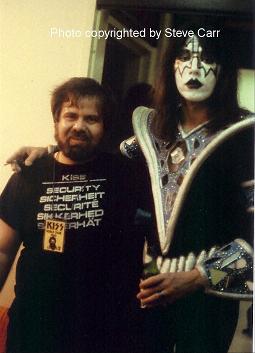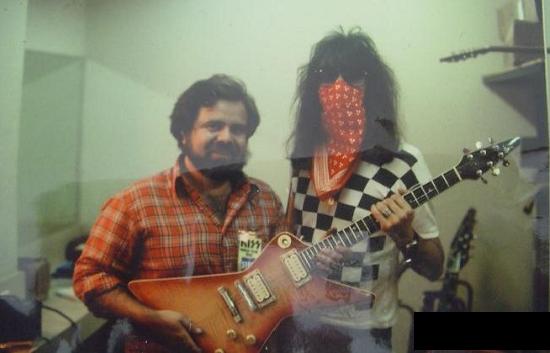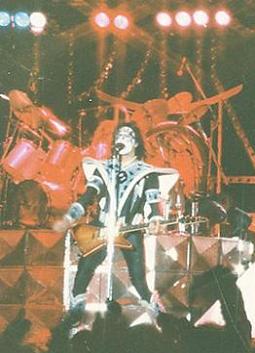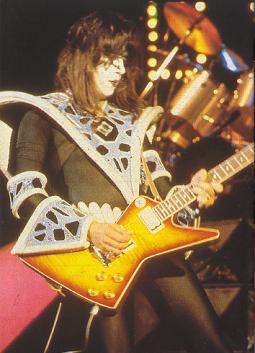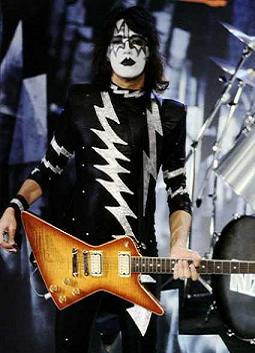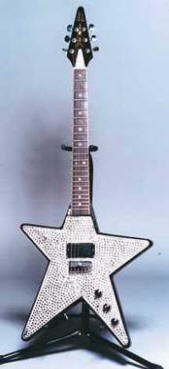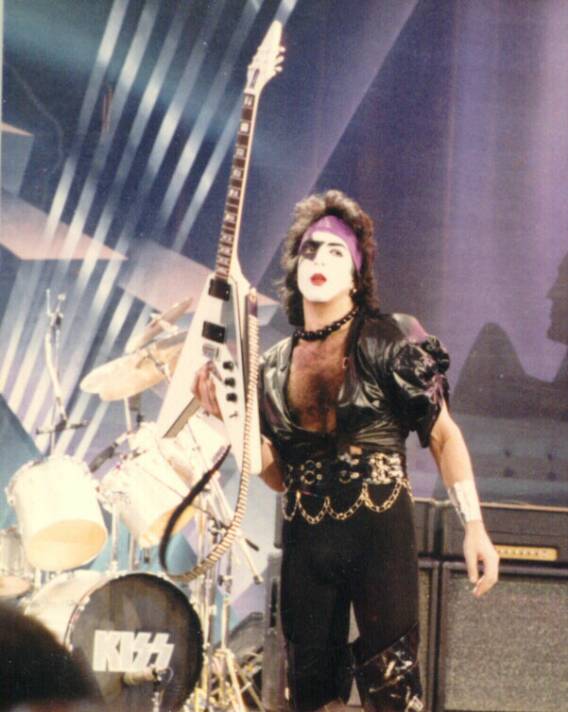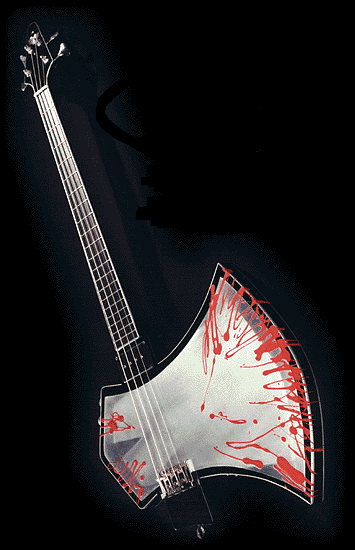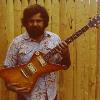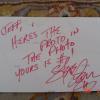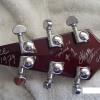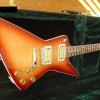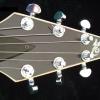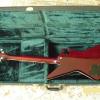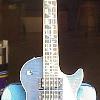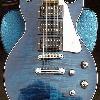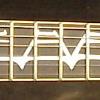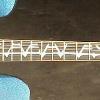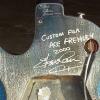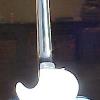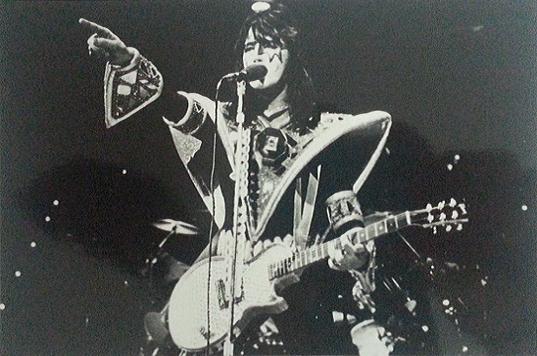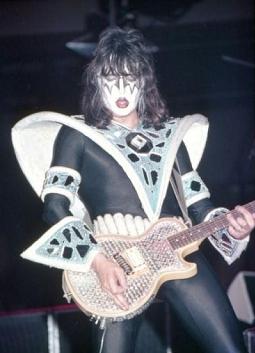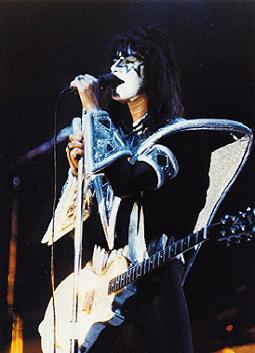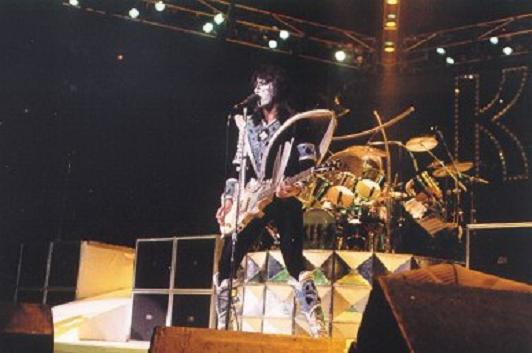Steve Carr Interview
In February of 2004, I was fortunate enough to be able to interview custom guitar builder and former Kiss guitar tech, Steve Carr, via e-mail, before his passing in, June of 2006. I sincerely appreciated his time, participation, kindness and willingness to answer any question I had. I felt very honoured to have had the opportunity. I hope you enjoy this piece of Kiss-tory as well.
Who is Steve Carr and what led you into custom guitar desiging / building ?
My Grandfather was a master woodworker, so my earliest memories are playing in his shop. He would give me a piece of wood and a chisel and I would occupy myself for hours while I was watching my Grandfather work on whatever. This early experience left me with a love of working with my hands that would stick with me. I started playing guitar at a very young age and started studying with Joe Sinacore, who was a great jazz guitarist. Joe had played with many notable entertainers of his time ... Patti Page, Frankie Lane and Bennie Goodman ... and he was also friendly with the greatest guitarist who ever lived, Django Reinhardt. Joe would let me work at his small guitar store, where he taught me the basics of guitar set-up. It was through Joe that I met Jimmy D'Aquisto; who was my mentor and showed me most of what I know today. Herk Favilla was a great builder who was like a second father to me and taught me how to use powertools to great advantage ! When John D'Angelico died, Herk wound up with his tools ... some of which he gave to me.
The first real paying job I got was working for Ronne D'Marino, who had the first real vintage shop in New York City. Ronnie was the first person to cultivate a celebrity clientel. While working for Ronnie, I had the opportunity to meet many of the more noted players of the early '70's. One of my first days working for Ronnie, he told me we had to go and pick up some work for 'John'. 'John' turned out to be John Lennon !! Imagine being a 19 year-old kid and going into the apartment of a 'Beatle' !?!?! I was speechless !! John was down to earth, very funny and was kind to me. So, as you can see, I started at the very top. I just happened to be in the right place, at the right time. Working with Ronnie taught me a very important lesson ... Stars are regular people and when you're the one responsible for their instrument(s), you have a special relationship with them that other's, in their employ, don't seem to have.
In the mid '70's I decided to start my own thing and I was very lucky in that I've always had more than enough work to keep me busy. At that time, many of the music stores in New York City started to use my services and refer their clients to me. Some of the players that I worked for included ... Twisted Sister, Billy Joel Band, Barry Gibb, Elvis Costello, Nick Lowe, Steve Martin, Brian Setzer, Paul Simon, Roy Buchanan, James Burton, Mick Ronson and many others. So, as you can see, I had pretty good experience dealing with famous players.
When did you and Ace Frehley start working together and what was the project that started your relationship ?
How I met Ace .... In 1978, my apprentice, William "Tex" Holmes was hired as a guitar tech for Ace. I wasn't exactly sure what Kiss was at that time (just some guys with clown makeup ?). They had needed some fretwork done and Tex convinced them to give me a try. It worked out well and I ended up with 40+ KISS guitars at my shop, to prep for their upcoming tour ! They were rehearsing at a local college, when I first got to meet them. Tex took me to a racquetball court and introduced me to a sweaty Gene Simmons, who was really working hard, to get in shape. Not exactly what I expected. Then I saw this guy with long hair and the strangest laugh I'd ever heard, playing with a pyro charge, trying to blow a hole through the marble floor. It seemed that the people at this field house had said the floor could not be damaged. This guy was trying to prove them wrong. It was Ace ! We hit it off right away and I still enjoy being around Ace, to this day.
The first project with KISS for me, was when Gene said he wanted a guitar shaped like and executioner's axe. I made several of these until we hit a design that is pretty much what he uses today.
The first project with Ace was a laser guitar. This was really a Les Paul Custom, look-a-like, built by me, with fibre optic cables and mercury switches. It has been well documented what a disaster the KISS laser show was .... Paul's laser eye piece, the laser curtain and Ace's guitar ... none of which was very safe or would pass by any fire marshalls. So, the original laser guitar became the first rocket launcher guitar. I think Ace was using a Tobacco Sunburst Smoker in 78-79, until he tried to hang it from a tuner, instead of the "hook", that was attached to the back of the headstock. I'm pretty sure that this one "took the fall in Rome", as they say. I have pictures of it in pieces !! I think I made the Black one, to replace the Sunburst. I also glued the broken one back together, as backup.
I gather that it was around this same period of time ('78-'79), that the idea for the first flasher/lighted guitar came to be. Was this your idea, or Ace's ? What details can you share about the guitar, without giving away all the trade secrets ?
The original light guitar (N.Y. Groove) was put together in 1979. It started life as a TV yellow, Les Paul Junior, circa 1957-58. The idea was Ace's. The electronic harness was put together by John Robison, whom we called "Ampy". I modified the guitar to accept the wiring harness and the battery pack. This was all done during a tour and when I delivered the guitar to Ace, he wanted me to re-fret it, in order for him to use it that night. The 'tune' room wasn't big enough for me to do this and Tex to prep the rest of the instruments. So, Ace and I searched the arena for a room that would suit our purposes. Unfortunately, Judas Priest was using it as a dressing room ! Ace had them relocated. After the US tour, we re-did the guitar, including a silver refinish complete with the Ace character that I inlaid, in pearl, in the headstock.
What do you know about Ace's older smokers ... particularly the one he used during the Destroyer tour ? This guitar had two cables plugged into it. Obviously, one going to the amp, but what was the second one for ?
Here's what I know about the brown sunburst smoker ... The two cords coming out of the guitar are the obvious "pre-transmitter" amp cable and the other is a mic cable, which supplied a low-voltage, phantom power to iginte the smoke bomb and power the internal lights. When I started with KISS, Ni-Cad batteries had been installed to replace the mic cord. The brown sunburst smoker is the same guitar that fell during the shooting gag, some years later. It was at that time that we put together first black smoker. The most obvious difference being that the new one was a Custom and the brown one was a Standard. After the 1980 European and Australian tours, I repaired the brown one and it became a backup at that point. In the early '90's, Ace sold the old smoker and it wound up in the hands of Steve Sils (KISS staff photographer) and Steve brought it to me to put back into working order. As far as I know, Steve still owns the instrument.
Here's an interesting smoker story .... on July 13, 1979, KISS played a huge show at the Pontiac Silverdome, outside of Detroit. It was Friday the 13th. I had to fly home after the show to do some additional work to the new smoker. Anytime that I had to fly home with any of the guitars at that time, we would purchase a seat for the guitar, so the baggage guys wouldn't use it for a frisbee. As the guitar went through the x-ray, the security people could see the excessive wiring and three sleeves of batteries, which did look like dynamite. They asked me to stand aside while they tried to determine if it was a bomb or not. The security supervisor picked it up and smelled it and was sure it was an explosive ! Then the police showed up and were really nervous about the whole incident. During all this, I was being held by two cops who didn't want to know what the device really was. After about 10 minutes of freaking out, I was finally allowed to speak with the officer in charge. I told him that if they let go of me, I could explain what was going on. I then very slowly stuck my hand into my jacket pocket and took out my KISS laminate pass, which had my photo and a description of "guitar specialist" on it. They all had a good laugh and were very sorry for my delay. , on the other hand, saw my life flashing before me and was just glad I didn't get shot by some nervous cop !! The airline didn't charge me for the extra seat, because of all this trouble. But the lady thought it funny when I asked her "who was going to pay for my change of underwear" ?!?!?
What can you tell me about the middle pickup inserts ? I don't believe it was a real pickup, but how was it made ?
I would take creme DiMarzio bobbins, slice them in half, glue on allen screw adjusters and mount them on a flat piece of plastic. Then attach the trim ring around it. I did this to most of Ace's guitars, at the time. This was done to present a look, without compromising the guitar itself. It could be argued that the middle tone chamber, actually increased the mid-range. But, most of Ace's Customs of that time had the center pickup applied with no rout underneath.
Back then, we never thought there would be as much interest in these instruments. If we had, we would have documented and preserved them.
1980 -
Steve Carr and Ace Frehley backstage and with the legendary Mini-Explorer that Steve built for Ace
**These images are used by permission of Steve Carr's estate. Duplication in whole or in part is prohibited, under penalty of law.
October 31, 1981 -
Studio 54, New York City, NY
Filming of the video for the song "I", off The Elder album
September 13, 1980 -
Rebstock-Gelande, Frankfurt, DE
Ace and the Mini-Explorer performing "Talk To Me", in Germany
July 25, 1980 -
The Palladium, New York City, NY
Ace and the Mini-Explorer during the "dress rehearsal" show, for the Unmasked tour
1980 -
These are a couple of the other Steve Carr built guitars. Although it was never used, Steve built the first
"Axe-bass" for Gene Simmons.
**These images are used by permission of Steve Carr's estate. Duplication in whole or in part is prohibited, under penalty of law.
2004 -
Steve Carr Mini-Explorer #1. Ace's was the prototype
**These images are used by permission of Jeff Donahoe and Steve Carr's estate.
Duplication in whole or in part is prohibited, under penalty of law.
2000 -
The custom built, Steve Carr Les Paul Rocket Launcher guitar
**These images are used by permission of Steve Carr's estate.
Duplication in whole or in part is prohibited, under penalty of law.
1979 -
The 1st version of Ace's New York Groove, Flasher guitar clearly still showing the original Gibson logo on the headstock
1979 -
Again with the 1st version of Ace's New York Groove, Flasher guitar clearly still showing the original Gibson logo on the headstock
January 28, 1982 -
Hammersmith Odeon, London, UK
Now with it's custom headstock inlay
